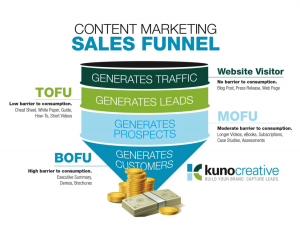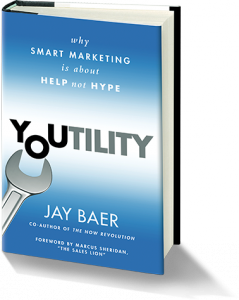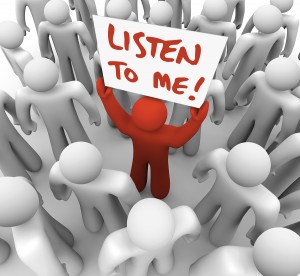June 24, 2014
 There’s always a lot of buzz about SEO (search engine optimization), SEM (search engine marketing) and of course, Google rankings.
There’s always a lot of buzz about SEO (search engine optimization), SEM (search engine marketing) and of course, Google rankings.
Rightly so – each of those plays a role in how effectively your website can serve you from a marketing and sales perspective. Your website should be sales funnel shaped.
But I think most companies approach the web a little like the fable about the five blind men who were asked to describe the elephant that stood before them. The man who was near the elephant’s leg reached out, touched the elephant and announced that an elephant was like a huge tree trunk. The man who was by the tail, after feeling it, described an elephant like a bullwhip and so on.
While none of them were wrong – none of them were right either. That’s exactly where many companies are when they think about how to leverage their website. They’re not wrong but they haven’t got it quite right either.
Lets step back and take a more holistic view of the website’s purpose for being. You might have a website because it:
- Gives you credibility – it proves that you’re real
- Tells the visitor what your company is all about and why you exist
- Lists/show what you sell/do
- Educates your prospect on how you are different from your competitors and help them make an more informed buying decision
- Helps your customers and prospects by making them smarter/better in some way
- Is an information repository so your customers can access things like users manuals, support forums, case studies, testimonials or other forms of thought leadership
- Provides ways to start a conversation, ask a question or give you feedback
- May serve as a shopping portal and people can buy right there
But if we step back even a little further and take a look from the 30,000 foot level, we can see through all those functionalities, your website is the entry point to your sales funnel. For most organizations today — your website is the initial point of entry that could lead to a sale today or five years from today.
That doesn’t happen by accident. Getting them to your site isn’t the end of the game; it’s just the beginning. Now your goal is to move them into and through your sales funnel. You have to build your site and everything that happens on it with that intention.
Whenever I think of a sales funnel, I picture one of those plastic funnels people use when they do an oil change. The top of it is really wide and the bottom is a very skinny hole. The funnel coincides with the know • like • trust equation.
The top of the sales funnel – know
The top of the funnel is for catching all those people who have no idea you exist or that you sell anything they might need or want. This is where you are hoping they’ll get to know you.
The middle of the funnel is filled with all the ways you either keep them on your site or get them to come back. With repeated exposure, you’re hoping they’ll come to like you.
The smallest section of the funnel is where you’re hoping they come to trust you through repeated interactions, you continuing to be helpful and demonstrating a consistency in how you talk, behave and perform.
Once they’ve willingly squeezed themselves through that tiny little section of the funnel, they’ll be ready to buy. But not before.
Let’s look at the first stage of the funnel (know) and what you can do to catch the interest of your web visitors and encourage them to get to know you a little.
At the top of the funnel we have people who’ve never heard of you and may have no idea they need or want what you sell. They might discover you by clicking on a link in a blog post or after reading about you in the newspaper. They might have a problem and be Googling to find a solution and your site is listed in their search results. They may see a Facebook ad or type in your URL off your business card that they picked up at a trade show. But at this point, you’re a stranger. They don’t know, like or trust you. And we know we have to earn their trust before we can earn their money.
At that moment, your website has to be helpful or relevant enough in some way that they spend a little time on it so they begin to get a sense of you and how you might matter to them.
This is a do or die moment. If the visitor pokes around the site and then leaves, they might never return and you’ll never know who they were or if you could have served them. That’s how it works on most websites. If I asked you to show me a list of people who were on your website in the last six months, could you do it?
One of the appealing aspects of using the web to pre-shop is the anonymity of it. To get someone to introduce themselves to you — you have to either give them a compelling reason to keep coming back or better yet, you have to create the opportunity for an information exchange. You have to offer them something that is valuable enough that they’ll give you their email address in return. While it sounds simple – think of how many websites you visit and how few capture your contact information.
What does that look like? You want to offer something that’s a low barrier to entry. It doesn’t feel too intrusive. It could be any of these:
- Sign up for our Enewsletter or regular tips
- Get a copy of a how-to report, whitepaper or cheat sheet
- Take an online course via email
- Get access to unique content behind a firewall
- Join a discussion group/closed forum
- Be notified when new content/information is available
- Download an eBook or watch a short video series
- Sign up for a webinar or phone conference
Once you’ve done made that initial connection and you have a way to stay in touch – you can continue to be helpful which will keep the conversation going. At that point, one of two things is going to happen. As they get to know you/your company – they’re either going to decide they like you or they don’t. Both are great outcomes.
If they like you, they’ll stay in the conversation and get to know you even better. If they don’t like you, they’ll go away. Now you don’t have to waste any energy on someone who was going to be a bad fit.
The middle section of the sales funnel – like
To move someone from the start of the process into this section requires a mix of bravery and generosity on your part.
Keep in mind that most prospects are pretty skittish. Whether it’s in a retail store or online, they’re used to being chased around by over eager salespeople that pester the poor potential buyer until they flee. That’s one of the reasons many people do a significant amount of their shopping online. The anonymity allows them to browse without pressure.
That’s why you want to load up your website with lots of content that has no barrier to consumption like blog posts, testimonials and FAQs. Those elements will generate traffic to your site. The strategies we talked about last week – where there is an exchange of information (their email address for some downloadable tool or content) begins to thin the herd. The tire kickers will avoid the opt-in level, preferring to stick with your free content. And that’s fine. Until they move to the next level, they’re not ready to buy. Once they trade you their email address for some content, they’ve indicated that they are open to hearing from you.
I find it hard to believe I have to actually say this but I’ve seen time and time again that I do. There is absolutely no reason to collect email addresses if you aren’t going to actually send them something.
And that something cannot be a sales pitch. I’ve seen so many businesses stumble here. They didn’t give you their email address so you could hard sell them or immediately try to get an appointment or schedule a sales call. They gave it to you so you would keep sending them information that’s valuable to them.
That is your litmus test. Each and every time, before you hit send, ask yourself “is this going to be valuable to my audience?” Time for a re-write if your honest answer is no.
Assuming you keep producing helpful content and you actually send it out consistently – the prospects will let you stay in their in box. Week (or month or quarter) after week, you’re there. You’re teaching, helping and they are getting a little smarter and a little more comfortable with you each time they hear from you.
You should also use those regular emails (or however you decide to connect with them) to drive them back to new content/offerings on the website. Maybe you produced a demo video series or you’re hosting an educational event that you’d like them to register for.
While we are focusing on your website, it certainly shouldn’t be the only tool in your toolbox. Your sales funnel should be armed with both digital and traditional tactics. They work together hand in glove, each strengthening the other.
The days of your website just being an online brochure are long gone. Be sure your web presence is the sales workhorse it should be by building a sales funnel around the know • like • trust = sales equation.
The last section of the sales funnel – trust
Having the right timing matters. You don’t get to this part of the funnel after the first couple interactions. If I see one consistent mistake, it’s that people shift into these sorts of strategy way too early. It’s like meeting someone in a bar and proposing the same night. Odds are you aren’t going to get too many yeses.
I totally get it from a business’ point of view and have often felt that frustration myself. You’ve shared your expertise. You’ve answered their questions. Surely they should be ready to buy by now. They obviously like what you do enough to keep coming back. So why aren’t they buying?
In my thirty years of being in business, I’ve rarely met a buyer who is as anxious to make the sale as the seller. Sure, there are those customers who come to us in crisis, and we scramble to put out their fire but they’re not the norm. So what do we do? We hang in there, and we keep being helpful and we work to stay top of mind until they’re ready to move forward.
The other factor to remember is that while we are the ones who build the sales funnel, it’s the prospect that moves through it and they control the pace and direction. So while one prospect may linger in the getting to know you (remember our know • like • trust = sales model) or growing to like you section for years, another may whip through both of those and be willing to trust you enough for a trial purchase in a matter of a couple visits.
For your website to truly be an effective sales funnel, you need to offer different levels of engagement, so the prospects can move themselves through at their own speed. As we talked about in the last couple columns, that means free content (text and video if possible) and content that you’ll give them for an email trade. But what kinds of things should you have available for those who are ready to consider a purchase?
Believe it or not – one that many companies miss is having contact information on the site. Don’t make me look for your phone number or email address. If you have the capacity, live chat is great. But make sure I can contact you and give me more than one method. If you have a brick and mortar presence, be sure you list your street addresses as well, with a link to one of the mapping sites.
You can also offer the ability to schedule a call, demo or take an assessment that will require you contact them (usually by email) with the results.
Remember that most buyers want to be pretty sure they’re going to buy before they speak to a salesperson or company representative. When they do reach out, they may have some final questions but they’re very close to making a buying decision. Which means you need to be ready to respond quickly once they do trigger that next level of readiness. Test your site and all your internal systems to verify that nothing is going to get in the way of you finally connecting with this potential buyer.
Today’s consumers want to be able to shop us on the web. How well that works for you is completely in your control. Is your site ready?
P.S. I found the great graphic on a SocialFresh blog post.
More
 We talk about the idea of creating trust every week with our clients. At my agency, MMG, we call this equation basic marketing math: Know + Like + Trust = Sales. Translated – you will never make a sale if the prospect doesn’t know you exist, doesn’t like both what you sell and who you are and ultimately, doesn’t trust you.
We talk about the idea of creating trust every week with our clients. At my agency, MMG, we call this equation basic marketing math: Know + Like + Trust = Sales. Translated – you will never make a sale if the prospect doesn’t know you exist, doesn’t like both what you sell and who you are and ultimately, doesn’t trust you.

 There’s always a lot of buzz about SEO (search engine optimization), SEM (search engine marketing) and of course, Google rankings.
There’s always a lot of buzz about SEO (search engine optimization), SEM (search engine marketing) and of course, Google rankings.

 Let’s look at the reality:
Let’s look at the reality:
 When you’re creating any sort of communication aimed at a potential buyer, you want them to do what?
When you’re creating any sort of communication aimed at a potential buyer, you want them to do what? I totally get that you are trying to make a living and that someone at your radio station, newspaper, TV station, magazine etc. says that my client should be advertising with you. And maybe they should.
I totally get that you are trying to make a living and that someone at your radio station, newspaper, TV station, magazine etc. says that my client should be advertising with you. And maybe they should.
 There’s a
There’s a 


